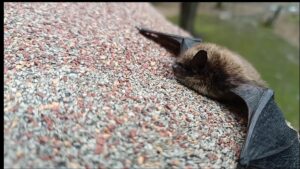The Little Brown Bat: Great to See One
In the quiet corners of Northeast Ohio, among the nooks and crannies of our homes and buildings, bats often find refuge.
 These elusive creatures, while often misunderstood, play a vital role in our ecosystem. Among the various species that call this region home, one stands out for its resilience in the face of adversity: the little brown bat (Myotis lucifugus).
These elusive creatures, while often misunderstood, play a vital role in our ecosystem. Among the various species that call this region home, one stands out for its resilience in the face of adversity: the little brown bat (Myotis lucifugus).
A Tale of Decline: White Nose Syndrome
The little brown bat has faced significant challenges in recent years, primarily due to the devastating impact of White Nose Syndrome (WNS). This fungal disease, first detected in North America in the early 2000s, has decimated bat populations across the continent. White Nose Syndrome disrupts bats’ hibernation patterns, leading to increased energy expenditure and ultimately death due to starvation and dehydration.
The little brown bat, once one of the most common bat species in North America, experienced staggering population declines as a result of WNS. Some estimates suggest that populations have declined by more than 90% in certain regions since the emergence of the disease. We haven’t seen many little brown bats over the last 10 years. This decline has prompted conservation efforts to protect and rehabilitate these vital members of our ecosystem.
These bats are nocturnal creatures, preferring to roost in dark, secluded spaces during the day and emerging at night to hunt for insects. They are agile flyers, capable of capturing hundreds of insects in a single night, making them valuable allies in controlling insect populations.
The Little Brown Bat: Characteristics and Habitat
The little brown bat, as its name suggests, is relatively small in size compared to other bat species. Adults typically weigh between 5 and 14 grams, with a wingspan of approximately 8 to 11 inches. One notable feature of the little brown bat is its fuzzy, dark brown fur, which covers its body and wings, giving it a distinctive appearance.
You can get a great view of a little brown bat in the video here. Ryan was surprised to find one so he wanted to share. You can see its small stature when compared to his fingers.

Little Brown Bat vs. Big Brown Bat
In Northeast Ohio, it’s not uncommon for wildlife removal experts like us at Frontline Animal Removal to encounter bats, particularly the big brown bat (Eptesicus fuscus), within homes and buildings. However, the recent discovery of a little brown bat by Ryan underscores the importance of understanding the diversity of bat species in our region.
While both little brown bats and big brown bats share similar ecological roles and habits, there are notable differences between the two species. Little brown bats tend to be smaller in size compared to their big brown counterparts. Additionally, their muzzle fur is typically longer and darker, giving them a distinct appearance.
Conclusion: Preserving Our Bat Species
As we continue our efforts to remove nuisance wildlife from homes and buildings in Northeast Ohio, it’s essential to remember the critical role that bats play in our ecosystem. Despite facing significant challenges such as White Nose Syndrome, the little brown bat exemplifies resilience and adaptation.
By understanding the unique characteristics and habitat requirements of bat species like the little brown bat, we can better appreciate and protect these valuable creatures. We can help get them out of houses without negatively impacting them.
At Frontline Animal Removal, we remain committed to promoting coexistence with bats while providing effective and humane solutions for unwanted bats in the home. Contact us today to learn more about our services and how we can help protect both your home and local wildlife populations

